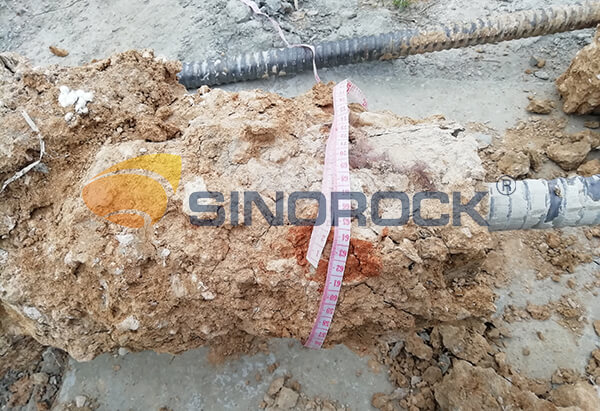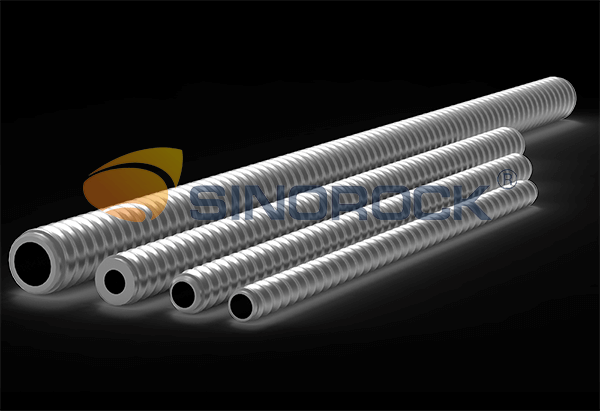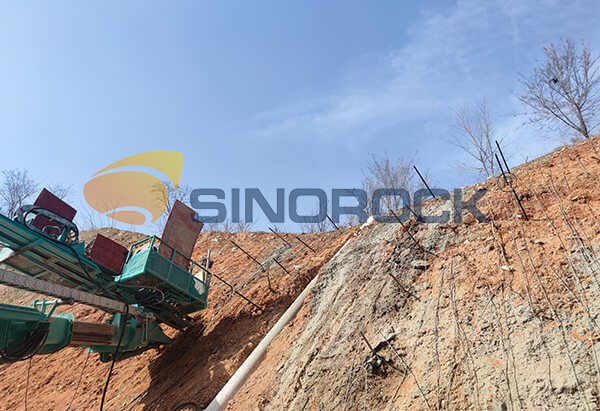3 Factors That Affect the Ultimate Load of Self Drilling Hollow Grouting Bolts
Time:2022-06-07From:sinorock View:
Due to the high ultimate load and yield load of the self-drilling hollow rock bolt, it is more and more commonly used in geotechnical anchoring projects, such as in railway tunnel advanced support, railway slope protection, highway tunnel advanced support, slope reinforcement, mining support, water conservancy projects, dam reinforcement, high-rise building foundations, and foundation support. So what is the anti-pull principle of self-drilling hollow grouting bolt? What are the influencing factors of the ultimate load of self-drilling rock anchors?
How Do self-drilling hollow grouting bolts Support?
The self-drilling hollow grouting bolt is drilled into the rock mass through a special drilling rig for rock bolts or other available equipment, and then the grout is injected into the drilling hole and rock mass fissure through the grouting machine. The hollow grouting anchor rod and the broken rock mass around the rod body together form an anchor body with an irregular surface, so as to play an anchoring effect. When the self-drilling hollow grouting bolt is stressed, the gripping force between itself and the surrounding cement mortar is transmitted to the mortar, and then transmitted to the surrounding rock mass. The self-drilling hollow bolt provides the anchoring force through the mutual friction between the rod body, the mortar, and the surrounding rock mass. That’s where the ultimate load comes from.
Factors Affecting Ultimate Load of Self-Drilling Hollow Grouting Bolts
The diameter of the anchor and the length of the anchor segment
The ultimate load of the self-drilling hollow grouting bolt is proportional to the diameter of the anchor rod and the length of the anchoring section. The larger the diameter of the anchor and the longer the length of the anchoring section (drilling depth), the greater the ultimate load is.

Shear strength of current geological rock mass
In the case of good construction technology, the ultimate load of self-drilling hollow grouting bolts is mainly closely related to the shear strength of rock and soil. Due to the large difference in shear strength of different rock and soil masses, the impact on the ultimate load of self-drilling hollow bolts is also large. In engineering design, the drilling angle and depth need to be carefully studied in order to improve the pullout resistance.
Grouting pressure
When the self-drilling hollow grouting bolt is grouting, the greater the pressure, the more the grout can penetrate into the cracks of the rock mass around the drilling hole to improve its original mechanical properties, increase the diameter of the anchor body and increase the diameter of the anchor body and the surrounding rock mass. The friction force of the self-drilling rock bolts is increased, thereby increasing the ultimate load. However, this factor is not without limitations. Tests have shown that when the grouting pressure exceeds 4Mpa, the impact on the pullout resistance of the self-drilling hollow grouting bolt becomes very small.
The factors affecting the ultimate load of the self-drilling hollow grouting bolt above are all discussed under the premise that the bolt diameter and wall thickness are the same. If the diameter and wall thickness becomes larger, the corresponding pull-out force will naturally be larger than that of the smaller ones.

Before designing and using self-drilling hollow grouting bolts, it is necessary to conduct a comprehensive and detailed survey of the geological conditions of the project, so that a more realistic plan can be designed and the quality of the project will be higher.
latest news
-

- What Are the Applications of SDA Bolts in Hydropower Stations?
- Time:2025-08-21From:This Site
- Learn how self-drilling anchor bolts enhance slope stability, tunnel support, and dam reinforcement in complex geological conditions at hydropower stations. Optimize hydropower projects with efficient, cost-effective, and eco-friendly solutions.
- View details
-

- Slope Stabilization with SDA Bolts: Benefits & Applications
- Time:2025-08-19From:This Site
- Discover how self-drilling anchor bolts (SDA bolts) provide superior slope stabilization for highways, railways, and tunnels. Learn their key benefits, installation process, and real-world applications in loose or collapsible soils.
- View details
-

- How Self-Drilling Rock Bolts Enhance Tunnel Support in Fractured Rock?
- Time:2025-08-15From:This Site
- Discover how self-drilling rock bolts enhance tunnel support in fractured rock. Learn their benefits, installation steps, and real-world applications for safe, efficient tunneling.
- View details
-

- Sinorock 2025 Quality Month | Strengthening Quality Foundations, Empowering Product Excellence
- Time:2025-08-13From:This Site
- Sinorock’s 2025 Quality Month, themed “Strengthening Quality Foundations, Empowering Product Excellence,” successfully concluded, reinforcing our commitment to superior product quality.
- View details
-

- Sinorock Safety Month 2025 | Everyone Speaks Safety, Everyone Can Respond
- Time:2025-07-03From:This Site
- Sinorock Safety Month 2025, centered on the theme "Everyone Speaks Safety, Everyone Can Respond - Spot Workplace Hazards," has wrapped up successfully!
- View details
-

- Quality Control: the Vital Factor of A SDA Bolt Factory
- Time:2025-01-09From:This Site
- Sinorock’s comprehensive quality control system, from supplier management to outgoing inspections, ensuring the highest standards for self-drilling anchor bolts in construction.
- View details
-

- Sinorock Invites You to Explore Proven Self-Drilling Anchor Bolt Solutions at bauma 2025
- Time:2025-03-07From:This Site
- From April 7–13, 2025, explore Sinorock’s Self-drilling anchor bolt solution at Booth C2.513/4 in Hall C2 of the Messe München Exhibition Center (Munich, Germany).
- View details
-
.jpg)
- SINOROCK to Attend EXPOMINA PERÚ 2024 in Lima, Peru
- Time:2024-08-10From:This Site
- Sinorock to Attend EXPOMINA PERÚ 2024 in Lima, Peru
- View details
-
.jpg)
- SINOROCK to Participate in MINING AND METALS CENTRAL ASIA 2024
- Time:2024-08-08From:This Site
- SINOROCK to Participate in MINING AND METALS CENTRAL ASIA 2024
- View details
 Download
Download 



